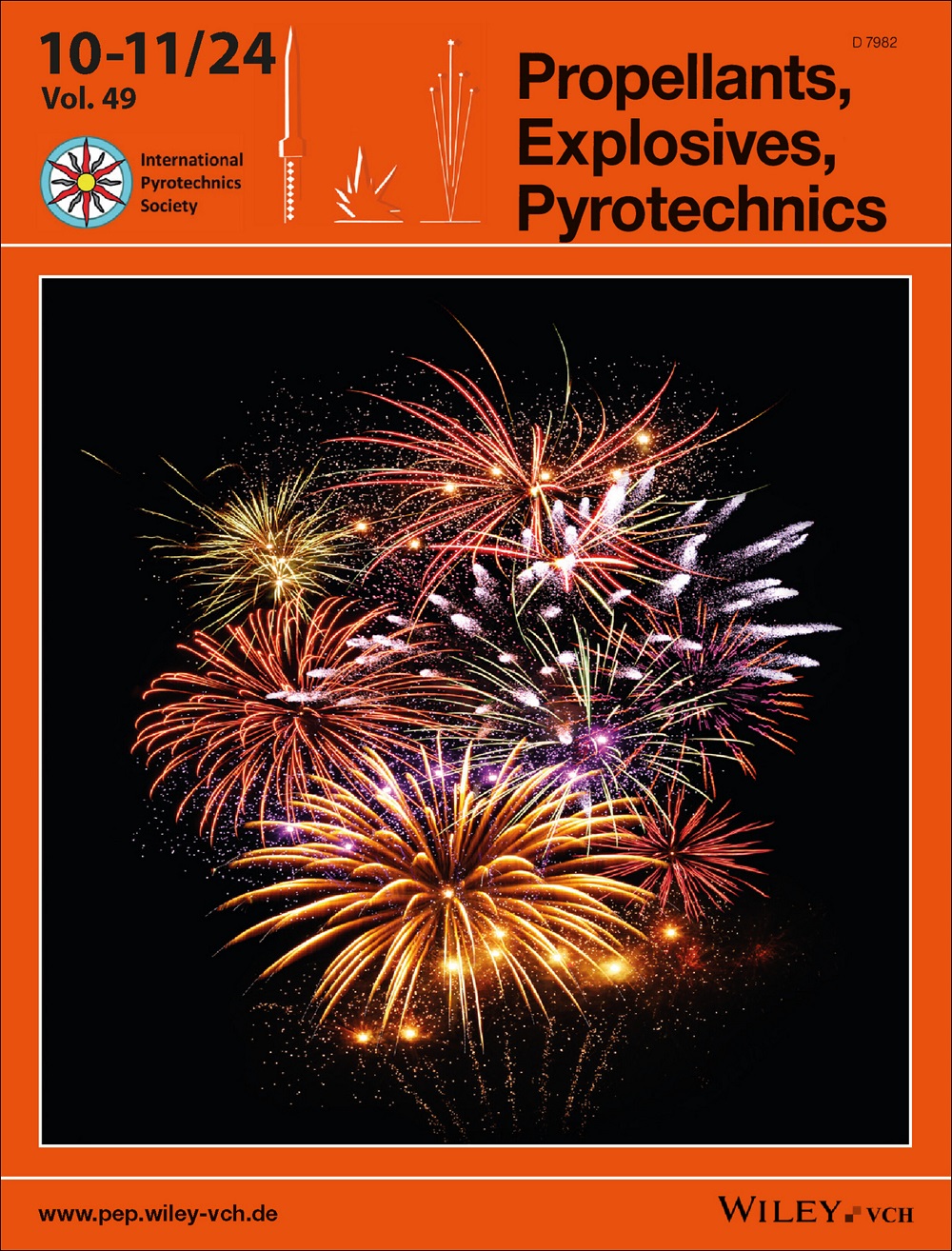Combustion of ammonium dinitramide based solid propellant with PBT as energetic binders
IF 2
4区 工程技术
Q3 CHEMISTRY, APPLIED
引用次数: 0
Abstract
Focusing on a new kind of solid propellants, which takes the ammonium dinitramide (ADN) as the high‐energetic oxidant, and 3,3‐bis(azidomethyl)oxetane and tetrahydrofuran copolymers (PBT) as the high‐energetic fuel binder, the burning rates and the theoretical performance of the propellant were measured under different ADN contents, ADN sizes and pressures. The burning rates increased from 7.9 mm/s to 117.4 mm/s and 49.1 mm/s to 74.2 mm/s when the pressure increased from 0.1 MPa to 10 MPa and from 12 MPa to 20 MPa separately, with a singularity in the pressure dependence of the burning rate at around 10 MPa. In terms of the effect of the ADN content, under the experiment pressures from 0.5 MPa to 5.0 MPa, the burning rates of the propellant were promoted by the increase of the oxidizer loading in a range of 50 wt% to 75 wt%, with a transition from a kinetically‐controlled reaction to a diffusion‐controlled one. Within the condition scope of this study, no obvious effect of the ADN sizes on the propellant combustion properties was observed. This could be attributed to the solid‐liquid mixed multiphase layer and the binder which served as a heat sink for the smaller ADN particles.

以二硝基胺为基础的固体推进剂与作为高能粘合剂的 PBT 一起燃烧
以一种新型固体推进剂为研究对象,以二硝基胺(ADN)为高能氧化剂,以3,3-双(叠氮甲基)氧杂环丁烷和四氢呋喃共聚物(PBT)为高能燃料粘合剂,测定了该推进剂在不同ADN含量、ADN尺寸和压力下的燃烧速率和理论性能。当压力分别从 0.1 兆帕增加到 10 兆帕和从 12 兆帕增加到 20 兆帕时,燃烧速率分别从 7.9 毫米/秒和 49.1 毫米/秒增加到 117.4 毫米/秒和 74.2 毫米/秒。在 ADN 含量的影响方面,在 0.5 MPa 至 5.0 MPa 的实验压力下,推进剂的燃烧速率在 50 wt% 至 75 wt% 的范围内随着氧化剂添加量的增加而提高,从动力学控制反应过渡到扩散控制反应。在本研究的条件范围内,没有观察到 ADN 尺寸对推进剂燃烧性能的明显影响。这可能是由于固液混合多相层和粘结剂为较小的 ADN 颗粒提供了散热。
本文章由计算机程序翻译,如有差异,请以英文原文为准。
求助全文
约1分钟内获得全文
求助全文
来源期刊

Propellants, Explosives, Pyrotechnics
工程技术-工程:化工
CiteScore
4.20
自引率
16.70%
发文量
235
审稿时长
2.7 months
期刊介绍:
Propellants, Explosives, Pyrotechnics (PEP) is an international, peer-reviewed journal containing Full Papers, Short Communications, critical Reviews, as well as details of forthcoming meetings and book reviews concerned with the research, development and production in relation to propellants, explosives, and pyrotechnics for all applications. Being the official journal of the International Pyrotechnics Society, PEP is a vital medium and the state-of-the-art forum for the exchange of science and technology in energetic materials. PEP is published 12 times a year.
PEP is devoted to advancing the science, technology and engineering elements in the storage and manipulation of chemical energy, specifically in propellants, explosives and pyrotechnics. Articles should provide scientific context, articulate impact, and be generally applicable to the energetic materials and wider scientific community. PEP is not a defense journal and does not feature the weaponization of materials and related systems or include information that would aid in the development or utilization of improvised explosive systems, e.g., synthesis routes to terrorist explosives.
文献相关原料
公司名称
产品信息
阿拉丁
Trimethylolpropane (TMP)
阿拉丁
Isophorone diisocyanate (IPDI)
 求助内容:
求助内容: 应助结果提醒方式:
应助结果提醒方式:


